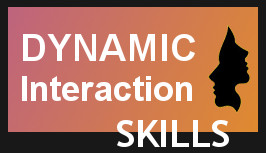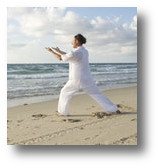The "Grounding" Process
The first two steps are about posture. You want to achieve a body position that is similar to a good starting position for sports, dance, martial arts, etc. You may find it awkward or uncomfortable at first because it is not your habit to stand this way but with practice you will become comfortable and the posture will become automatic. Remember these are generic instructions, so discover what works best for you.
1. Lower Body:
The lower part of your body is your base. It is what holds you up and connects you to the ground. You want three things from this part: a strong base, flexibility, and contact with the
earth.
First you want strength. Stand with your feet about a shoulder’s length apart, toes pointed forward, parallel to each other. Remember that one goal here is to create an open channel for your emotional “electricity” to flow from your face, shoulders, hands, and chest (where you often feel things the most) to your legs and feet and into the ground. Keeping your toes forward (not pointed out to the sides) keeps your pelvis from tightening and restricting the flow of energy to your legs.
If your stance is too wide you lose flexibility. If it is too narrow you lose strength and balance. Unlock your knees. You do not have to bend them much but if they are locked you lose flow and flexibility.
My martial arts instructor showed us that if our knees are unlocked, we can avoid an attack without losing ground. Unlocked knees allow you to bend and turn. Keep your weight over the balls of your feet
and feel your feet against the ground, making sure you have good, solid contact. Tilt the hips slightly forward to stay open and add balance. Play with this position to develop a stance that works for you.
2.
Upper body:
Now turn your attention to your upper body. You want a posture that expresses self worth, power, and confidence.
Hold a shape that feels this way but is relaxed. Just enough energy to hold this shape without extra tension. It should be more comfortable as you get used to it. Your weight should be distributed equally over your legs and your head neck and spine vertical. Your arms and hands are hanging relaxed at your side.
Now we'll proceed with breathing, relaxation and self- talk to complete the process.
Eventually all of these steps will blend into one as you respond to your desire to ground. Practice them sequentially at first so as to integrate each step carefully and competently.

